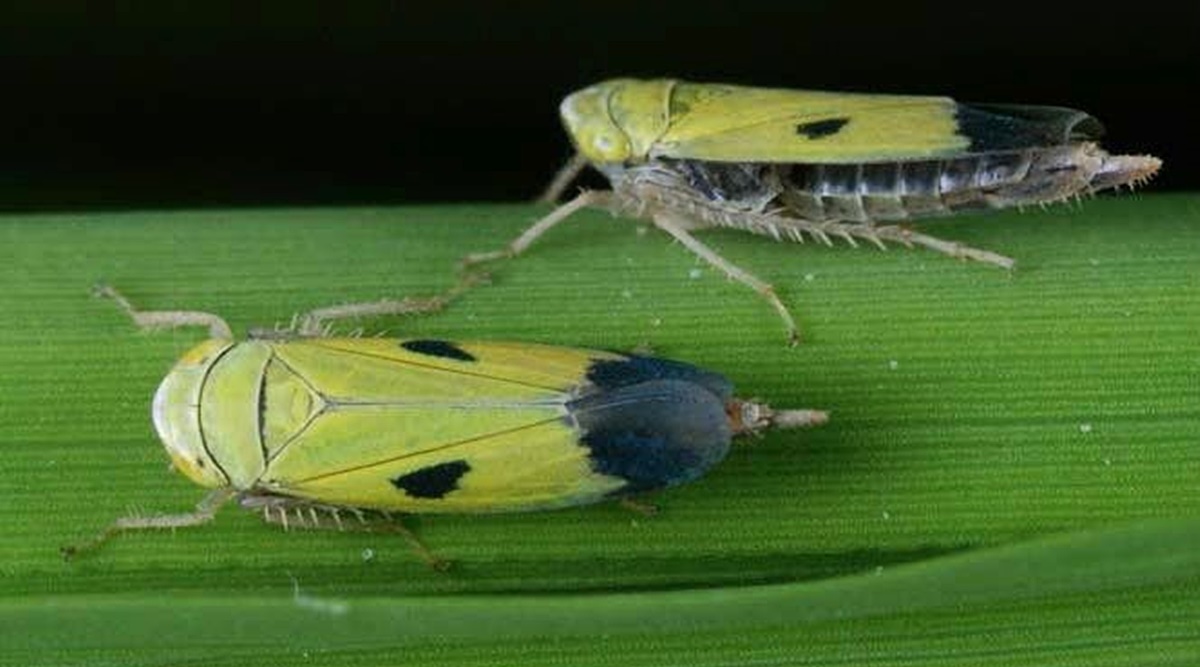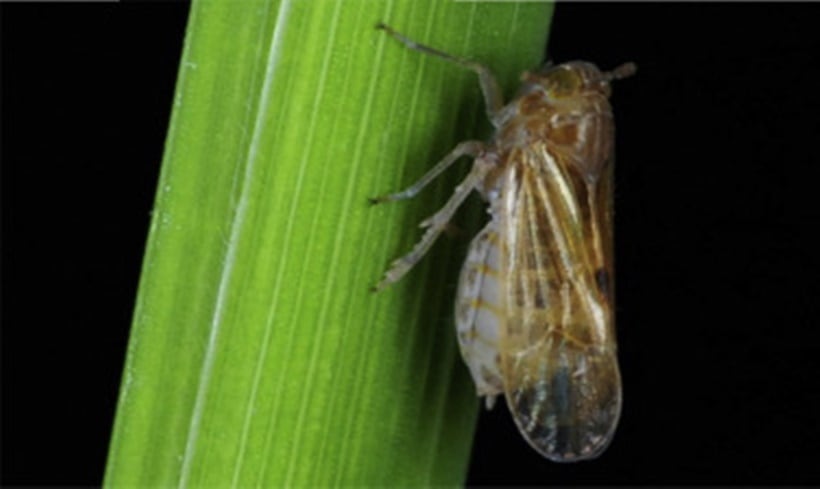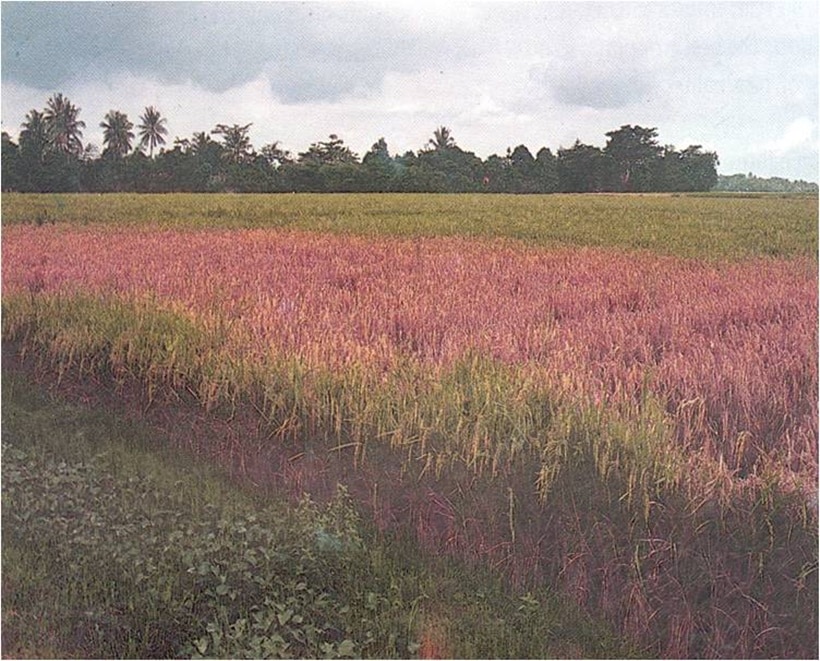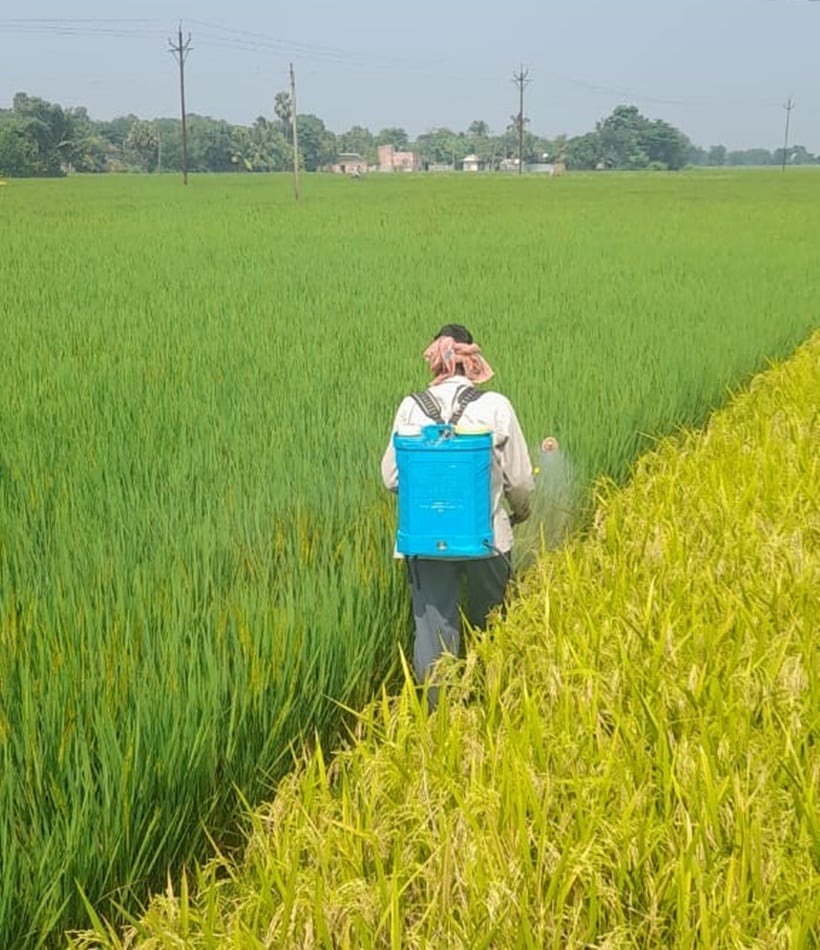 The insect feeds on rice by sucking the plant sap and causes damage to the crop by either directly sucking the sap or indirectly, by transmitting viral diseases. (Photo credit: Centre for Agriculture and Bioscience International)
The insect feeds on rice by sucking the plant sap and causes damage to the crop by either directly sucking the sap or indirectly, by transmitting viral diseases. (Photo credit: Centre for Agriculture and Bioscience International)Every year between October to November, India’s rice-producing states witness an infestation of a small insect, rarely bigger than 10 mm in length. Two species of this insect, the green leafhopper, are the Nephotettix virescens and the Nephotettix nigropictus, and are found in the Indian subcontinent. But for many in West Bengal, including farmers, the insect is most commonly identified by its name in Bengali — shyama poka.
Outside the fields of agricultural and biological sciences, especially in West Bengal, the “arrival” of this insect marks the start of the autumnal festivals of Diwali and Kali Puja. Weeks before the festival, at dusk, the green leafhoppers descend in droves wherever they find a light source, buzzing around light bulbs, and even mobile phone screens, attracted by the brightness, remaining till the light source is available. The next morning, the carcass of the green leafhopper is found strewn across surfaces where they may have fallen after the light source was turned off.
Carrier of diseases
Over the past few years, people accustomed to witnessing the onslaught of the green leafhopper during this season, even in urban areas, have wondered where the shyama poka have all gone. But it isn’t as much as the insects having “gone away” as it is about the impact of environmental and other complex external factors on the species which has resulted in people seeing them in fewer numbers than before, agricultural scientists say.
“The green leafhopper is an insect associated with the rice plant, so wherever rice is grown, you will see the green leafhopper,” says Dr. Santosh Kumar Roy, the former joint director of agriculture (Entomology) with the West Bengal government. While the arrival of the predominant and widespread green leafhopper marks the start of the festival season, there is little awareness of how the leafhopper is categorised as a serious pest by agricultural scientists and farmers, that cause severe crop damage by direct feeding or indirect transmission of major viral diseases.
The green leafhopper is a carrier of the tungro disease, which affects cultivated rice, and causes stunted growth, leaf discolouration, reduced tiller numbers and sterile or partly filled grains. The insect feeds on rice by sucking the plant sap and causes damage to the crop by either directly sucking the sap or indirectly, by transmitting viral diseases — in this case, the tungro virus. It is this method of drawing or sucking sap from the rice plant from where the insect gets another one of its local names, shoshok, in Bengali. While mild infestations may reduce the health of the rice plants and the number of productive tillers, heavy infestation causes withering and complete drying of the crop, which can be devastating for regions where rice is the primary crop, as in the case of West Bengal.
Despite the prevalence of the green leafhopper in the region, an official of West Bengal’s State Biodiversity Board, which deals with matters relating to the conservation of biodiversity, and monitors the population of species, told indianexpress.com that it does not have statistics regarding the population of this species. However, over the past few decades, agricultural scientists who focus on rice research and associated pests, have been monitoring the green leafhopper, and have been recording some data specific to the insect.
“The green leafhopper is endemic to certain regions, but it is true that their numbers have reduced. That is in part because the spread of tungro virus has been controlled,” says Dr. Roy. In the absence of species-specific data, agricultural scientists have been only able to monitor the impact of this virus on rice plants in the region to estimate the population of the green leafhopper.
Tackling infestations
In West Bengal’s Hooghly district, Palash Pal, 48, has been simultaneously working as a farmer and running a family business selling pesticides and insecticides. In his farms spread across an approximately 30 km radius in Chanditala town’s Block I and Block II, and Jangipara town, Pal has been growing rice and potatoes, and has witnessed the impact of the green leafhopper for over the two decades that he has been in the business. This year, however, he and his colleagues engaged in farming in this district, have not seen any significant damage caused by the green leafhopper, causing them to believe that pesticides and insecticides perhaps mean that the worst infestations are possibly behind them.
“Pesticides usually have to be sprayed 10-15 days before the onset of the insects and this year, we haven’t received many reports of infections,” says Pal. He points to farms near Arambagh, a town in the Hooghly district, some two hours away from Chanditala, one of the several places in the state where varieties of aromatic rice, like Gobindobhog and Basmati, are grown, that are more prone to pest attacks. “They will spray pesticides up to three to four times per season to protect the rice crop from the green leafhopper. But this year, because the fields got less rainfall, farmers didn’t have to spray too much,” explains Pal.
 The brown planthopper (Nilaparvata lugens), called the badami shoshok poka in Bengali, has a brown colouring and looks similar to the green leafhopper in size and some other physical features.(Photo credit: IRRI (2009))
The brown planthopper (Nilaparvata lugens), called the badami shoshok poka in Bengali, has a brown colouring and looks similar to the green leafhopper in size and some other physical features.(Photo credit: IRRI (2009)) While the green leafhopper is more distinct and visible because of its green colouring and black markings on its body, there is a similar insect that arrives around the same time. The brown planthopper (Nilaparvata lugens), called the badami shoshok poka in Bengali, has a brown colouring and looks similar to the green leafhopper in size and some other physical features. Like the green leafhopper, it gets attracted to light sources, but few outside the agriculture and scientific community are able to accurately identify the insect as one that falls in the leafhopper family.
 Crops infested by shyama poka. (Photo credit: Tamil Nadu Agricultural University)
Crops infested by shyama poka. (Photo credit: Tamil Nadu Agricultural University) Despite its nondescript colouring, the brown planthopper leaves a more devastating impact on crops and crop fields, says Dr. Roy. Attacks by the brown planthopper result in the drying of the affected plant, which gives it a scorched appearance called “hopper burn”. Agricultural scientists in India have recorded circular patches of drying or “burn” and the lodging of matured plants. Lodging in agricultural science refers to the permanent displacement of the parts of a crop above ground, from its regular, upright position. Very simply, because of the attack of the brown planthopper, the plant collapses. The brown planthopper is also a carrier or vector of the grassy stunt, ragged stunt, and wilted stunt diseases.
“I have started getting reports from across the state that hopper burns are being witnessed, with requests for help regarding recommendations for the kinds of pesticides that farmers should use,” says an agricultural scientist, requesting anonymity.
Reasons behind fall in numbers
In addition to the increase in the use of pesticides to tackle the green leafhopper and the brown leafhopper, there are other reasons that have contributed to the visible decline in the numbers of the insect, particularly the green leafhopper. Dr. Roy attributes the fall in numbers to factors like weather, temperature, and climate change. “High humid conditions are required for this insect, but this year, we didn’t get a lot of rain. The prolonged dry spell, high temperatures, and scattered rainfall impacted the larvae and the subsequent population of the green leafhopper,” he explains.
Urban planning and associated factors have also inadvertently played a role in the diminishing numbers of the green leafhopper, an agricultural scientist interviewed for this report told indianexpress.com, requesting anonymity. “Kolkata has grown substantially over the years. Earlier, rice used to be grown on the fringes of the city, but we don’t see that anymore. So, where are the shyama pokas going to come from in the city?” he asks.
He points to the rapid development and growth of the state’s capital that has pushed paddy cultivation further into the interiors of West Bengal state. “Even 20-30 years ago, rice would be grown in the outskirts of Kolkata. If there is no rice cultivation, there is no shyama poka. This is one of the reasons why people living in Kolkata do not see as many green leafhoppers as they would till even a few years ago,” the agricultural scientist says. “I stay in a semi-urban area and there is no rice cultivation here. So while green leafhoppers are visible here, the numbers are fewer. To expect it in big numbers in urban areas like Kolkata is futile. Without a rice plant, the green leafhopper cannot complete its life cycle,” he explains.
He isn’t surprised that the drop in number of the green leafhopper has been noticed by West Bengal’s residents, because of its longstanding cultural association with the festivals of Diwali and Kali Puja. The festivals are almost synonymous with the large-scale presence of the green leafhopper. The insect’s local name in Bengali, shyama is derived from the festival of Kali Puja as Shyama is another name for Goddess Kali who is worshipped during this festival.
A characteristic noticed among insects is their propensity to remain in crop fields during the day, where they are attracted to light sources during the dark. Over generations, farmers across riverine India have created several traditions which essentially worked as a pest control method in the absence of chemical insecticides and pesticides. In rural India today, there are several traditional practices that are still followed, where a fire is lit close to crop fields, in a controlled environment. For instance, during Diwali in riverine West Bengal and Odisha, some communities practice a tradition where bundles of jute sticks, called paat kaathi in Bengali and kaunria kanthi in Odia, are burnt after dark. The burning of these sticks, left behind by farmers in jute fields after harvest, is essentially used to attract the green leafhopper, after which it eventually dies.
Dr. Roy points to the festival of Bhoot Chaturdashi in West Bengal that occurs on the night before Diwali, and Diwali itself, where ritualistic practices of “aagun dewa” are conducted, which involve burning earthen lamps, fireworks, and other sources of light. While the traditions have been practiced for centuries, Dr. Roy says that the scientific reason behind them may have been to generate these light sources to curb the population of seasonal insects and pests like the green leafhopper. “It was a traditional control process because their arrival coincided with the insect’s breeding and when they would come out in the highest numbers,” he says. The concept works in a way similar to the light trap used by agricultural scientists in the field, where light sources are used to catch insects for study.
There may be another reason for the fewer numbers of green leafhoppers, the entomologists interviewed for this report say. “Even till a few decades ago, we didn’t have such a diverse range of light sources. These days, even across rural India, an ordinary house would have more than one light bulb in operation, in addition to other sources of light like mobile phones. Back then, the light source was concentrated and the green leafhopper would be concentrated around that. With so many sources of light, their numbers are perhaps scattered and that is interpreted as a severe reduction in numbers, but this is just a speculation,” the agricultural scientist cited above says.
Excessive use of insecticide and pesticide has certainly contributed to the reduced numbers, but not just of the green leafhopper, but several other kinds of insects, experts say. It is also possible that in India’s rice belt, the green leafhopper is simply not a dominant insect or pest species any more, and has been replaced by another one, but there is not enough data to confirm this.
 Excessive use of insecticide and pesticide has certainly contributed to the reduced numbers, but not just of the green leafhopper, but several other kinds of insects, experts say. (Special Arrangement)
Excessive use of insecticide and pesticide has certainly contributed to the reduced numbers, but not just of the green leafhopper, but several other kinds of insects, experts say. (Special Arrangement) The green leafhopper thrives in less rain and in low, cooler temperatures, and is unable to grow in too much stagnant water. This year, the prolonged rain has contributed to a slow increase in their numbers. “If the rains are prolonged, they grow slowly, by which time the rice is harvested. So they emerge from the pupal stage but they don’t get the host plant and we see a die-off,” the agricultural scientist explains.
There is a consensus among experts that globally leafhoppers are an understudied group among insects, in part because of the small size and the wide range of leafhoppers that are found around the world. While they are categorised as pests, and dreaded by farmers, they do play important roles in the ecosystem. They host parasitising insects, act as vectors of bacterial and fungal plant pathogens, and are also known to form symbiotic relations with other organisms, like ants for instance, that feed on the leafhopper’s sugary secretions.
The goal is not to eradicate the green leafhopper, say entomologists interviewed for this report. “We don’t want the species to die out, which is why we use the term ‘control’ when it comes to pest management. If there is 100 percent of one species in an area, I will try to reduce the numbers of it, after which my crop loss will be less,” says Dr. Roy. Entomologists discourage eradication of species, even those categorised as pests, because whichever species replaces it, will be even more virulent and predominant, he explains. There are also concerns about the excessive use of insecticides and pesticides by farmers because it results in harmful residue in fields and crops, which is in turn harmful to the ecology.
The shyama poka has not gone anywhere, entomologists say. It is just a combination of factors that have made them less visible.